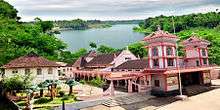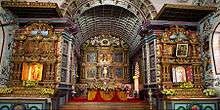Kanjoor
Kanjoor is a small town near to Aluva. It is in Ernakulam district in the state of Kerala, India. The estimated population is 19,712.[1]


History
In olden times, at Kanjoor, there used to be an office of the princely state of Kochi, probably for collection of taxes. This was referred to as Kachery in the local language and the present day town of Kanjoor came to be referred as 'Kacheryparamb'. There used to be a police station also in Kanjoor. Though it was referred to as police station, it was nothing but a police beat room for recording the observations made on their beats.
Etymology
It is said that the Kochi dynasty travelled from places like Vannery and Thiruvalwamala and such other places thereabout in search of safer locales to settle down fearing the onslaught of marauding army of Zamorins of Calicut. Accordingly, at some of time, Puthiyedam was considered to be a place for settling down. They aptly named it as 'puthiya idam' meaning the new place. The two kovilakams, which can extend its matrilineal roots to the royals of Kochi, that exist on either side of the temple, bears testimony to the fact that this place was indeed used as a settlement by the members of royal family. The presence of other kshatriya families around this place corroborates these facts.
Administration
Kanjoor is a panchayat in the Ernakulam District. It has as many as 15 wards.
The panchayat can be divided into places like thuravunkara on the north-west, kozhikkadanpady-thattanpady in the west, puthiyedam on the south, parappuram on the east and arankaavu in the north-east.
Geography
River Periyar that separates neighboring panchayats from it helps to meet not only the water needs of the people but also provides employment. Kanjoor is nearly 5 km away from Kochi international airport
Education
The panchayat has four high schools and seven lower division schools. Among these, St. Sebastian's High School, Kanjoor is the renowned school which established in 1912.
Economy
Just as the case for most other Gram panchayats in Kerala, the main occupation of the people of this panchayat is agriculture and allied works. NRI population of the panchayat is not comparable with many other panchayats and is in fact, very low. Inter-religious ratios are much in alliance with the state ratio in this regard. Ezhavas and Nairs in that order remain the most prominent Hindu communities in this panchayat.
Worship Centers
The main religious centres in this village are Kanjoor Church and Puthiyedam Temple.
Kanjoor Church: St. Mary's Forane Church Kanjoor, one of the historic Churches in India. The Saint Sebastian at kanjoor, The Kanjoor Punyavalan is the Living saint who removes all the diseases and epidemics.St. Sebastian is known for his quick reply to those who call on him in distress especially those who seek the assistance of the saint for deliverance from incurable diseases, epidemics, and shattering problems of life. A lot of incidents illustrating the power and the divine nature of the Saint of Kanjoor, still live on in the minds of the locals and devotees. The festival in the church comes on 19 and 20 January every year, and is celebrated by all in Kanjoor irrespective on religion or cast. The eighth day of the feast is celebrated on 26th and 27th January.
Puthiyedam Temple: The main deity is standing posture of "parthasarathy" strangely holding butter in his right hand rather than a weapon. However, the temple is renowned for its bhagavathy temple. Legend has it that this bhagavathy was worshiped by one among the many maternal branches of the then-local kings of Kochi dynasty as their mother goddess, when they lived in this part of the village. Sakthan Thampuran, probably the only king worth his name in Kochi dynasty, was born in this place. Old timers say that the temple was constructed in this current shape during his time of rulership. This temple had the now defunct and detestable practice of 'aal thookkam'. 'All Thookkam', when translated to English would mean dangling of human beings, This was a religious practice in which the man either opted or identified by the community to do the performance would at first allow himself to bear the inscrutable pain of piercing his flesh on the back of his body with iron hooks and then dangle in the hooks. Thereafter the man thus dangling would then be taken for circumambulation in a specially made wooden structure. Kodungallor Kunjukkuttan thampuran has written few slokas on this deity.
Festivals
The annual festival of the temple is performed every summer during the Malayalam month menam in such a way that the 'aaraatu' will coincide on thiruvonam. Accordingly, chothi of meenam month shall be the kodiyett. To repopitiate the goddess guruthy is performed during the annual festival. During mandala kaalam daily 'kalam pooja' is performed. Apart from the above poomoodal also is being performed on the deity during mandala pooja days.
The famous kanjoor church feast is celebrated on Jan 19th and 20th of every year.
References
- Source : Census data 2001